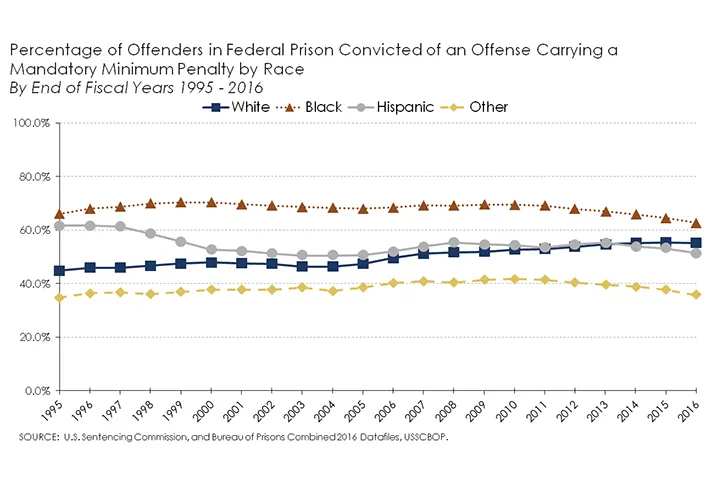
The number of federal prison inmates convicted under mandatory minimum laws decreased by 14 percent from 2010 to 2016, although they still make up more than half of all federal inmates, according to a new report by the United States Sentencing Commission.
There were 92,870 federal inmates convicted of an offense carrying a mandatory minimum penalty, as of September 30, 2016, compared with 108,022 inmates on the same date in 2010. Still, mandatory minimum inmates accounted for 55.7 percent of all inmates in Bureau of Prisons custody in 2016, a slight decline from 2010, when they made up 58.6 percent of the total, the commission reported in its 2017 Overview of Mandatory Minimum Penalties in the Federal Criminal Justice System, published this month.
The commission noted that the decline is consistent with the downward trend in the overall federal prison population since 2012 and attributed it to the easing of some of the more stringent penalties for drug violations in recent years and by accompanying changes to sentencing guidelines.
In both 2010 and 2013, the Department of Justice instructed prosecutors to be more selective in charging offenses with a mandatory minimum penalty, specifically for nonviolent, low-level drug crimes. Also in 2010, Congress passed the Fair Sentencing Act, which reduced mandatory minimum sentences for some drug offenses. For example, Congress repealed the mandatory minimum for simple possession of crack cocaine and increased the quantities of the drug that trigger stiffer penalties in crack cocaine trafficking cases.
The commission noted that the Justice Department this year rescinded its 2010 and 2013 guidance, which could impact trends.
The report is the first major update of the commission’s analysis of the impact of mandatory minimum penalties since 2011. Mandatory minimum penalties are minimum terms of imprisonment for people convicted of certain offenses. Most convictions carrying mandatory minimums involve drug trafficking, firearms, identity theft, and child sex offenses.
Among the report’s other key findings:
-
In fiscal year 2016 (ending September 30, 2016), one-fifth of all federal offenders (21.9 percent) were convicted of offenses carrying mandatory minimum sentences. In fiscal year 2010, 27.2 percent of all offenders fell into that category.
-
There are regional disparities in mandatory minimum sentencing, with high concentrations in Texas and Florida. In fiscal year 2016, there were 1,003 offenders in the Southern District of Texas who were convicted of crimes carrying mandatory minimums, accounting for 7.4 percent of the 13,604 offenders nationally convicted under mandatory minimums. The Southern District of Florida had 733 mandatory minimum offenders, 5.4 percent of the national total.
Three other districts reported at least 500 cases involving convictions with attendant mandatory minimums: Western Texas (676), Middle Florida (636), and Puerto Rico (527). In the five districts with the highest rates, drug and firearm offenses made up a significant portion of the districts’ caseloads. The majority of the 94 court districts reported 250 mandatory minimum cases or fewer.
-
Drug-related offenses, particularly drug trafficking, accounted for about two-thirds of the total offenses carrying a mandatory minimum (67.3 percent) in 2016. The next largest category was pornography (6.9 percent), followed by firearms (5.7 percent), and sexual abuse (5.2 percent). Other federal crimes comprised 15 percent of the total.
-
In 2016, 62.6 percent of all federal sexual abuse and pornography offenders were convicted of crimes with mandatory minimum sentences, up from 52.6 percent in 2010. The commission noted that the anti-child pornography PROTECT Act of 2003 contributed significantly to a sixty-fold increase in the rate of child pornography offenders convicted with mandatory minimum sentences since its first report on mandatory minimums was published in 1991.
-
As they did in 2010, Hispanic offenders represented the largest group (40.4 percent) convicted of an offense carrying a mandatory minimum sentence in 2016. Black offenders constituted 29.7 percent of the total, white offenders 27.2 percent, and other races 2.7 percent.
However, unlike in 2010, whites convicted under mandatory minimums got longer mandatory minimum sentences than the other groups. Their average sentence in 2016 was 127 months, followed by black offenders with an average sentence of 119 months, and Hispanic offenders with 93 months. In 2010, black offenders sentenced to mandatory minimums had the highest average sentence at 127 months, followed by white offenders with 102 months.
Subscribe to News Updates
Subscribe to be notified when the news section is updated.
